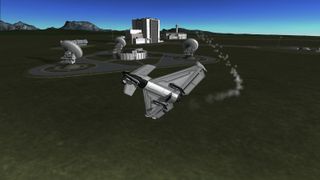
Kerbal Space Program is a space program administration and flight simulation game, putting you in charge of Kerbals, an alien race. You can create and fly almost anything your imagination will allow, and send Kerbals to explore the universe beyond their own planet, Kermin.
I've pieced this rudimentary space rocket haphazardly, I didn't even do the tutorial before I dived into this space program simulator. I was that excited.
Before I nerd out on everything that entails completely, Jebediah and Bill are looking wet-your-pants excited and terrified respectively. They're strapped into the cockpit of the lovingly named "Twig and Berries" because I'm childish.
I gave it the full throttle treatment, and my rocket began to rise so slowly I thought it wouldn't make it off the ground at all. But by Jove, I got the ruddy thing all the way into orbit! Since it was only a basic rocket, I didn't take into account that I'd need to get the boys back down again, safely.
Building the rockets is the 'easy' bit — I'll get to that in a moment — but the rest of Kerbal Space Program is about as close to running NASA from home as you're likely to get.
Playing outside the sandbox mode, you're in charge of the entire space program, from administration, pilot hiring, building crafts and allocating research points. You'll need to balance the sheets and build up a positive reputation. There is a whole galaxy of content available in Kerbal Space Program.
- Sandbox mode is a free-play mode, where you have unlimited funds, reputation, and all vehicle parts unlocked. Scientific research and administration are unavailable because you don't need them.
- Science mode requires you to perform scientific research, but the administration of the space base is unavailable.
- Career mode lets you handle the running of every aspect of the space program.
Even if you think you know a fair bit about how space stuff works, playing through the tutorial and some of the scenarios should be a good place to begin. It gives you all the information you need step by step in your new space administration career in real detail, so it would probably hinder your progression somewhat to avoid it.
During the tutorial, I thought I'd run into a snag barely even a few steps in. Werner Von Kerbal (a play on Werner Von Braun, the pioneering German rocket scientist) gives detailed instructions on how to build my first rocket, but I couldn't maneuver the parts around to get them to connect. Little did I realize that any on-screen prompts can be moved, giving me clear access to every little inch of my tiny pod. The majority of the crafting is done via a cursor, which is understandable given the need for finer detailed placing. But navigating menus sidebars with a cursor to get to new content further down is honestly a pain for controller users when the scroll of a mouse wheel would have eliminated this need on PC.

Building bigger things than a single fuel tank rocket with a command pod on top is slightly more of a feat.
When you're not building a simple straight in-line rocket, you begin to take all sorts of other things into account. The center of gravity, the center of thrust, your engines have to be aligned so you don't spin out of control when you blast off. The problem here is that the snap-to feature only works in the sense that it will connect the two parts, whether they make sense to go that way together or not. You have to adjust the angle you want it to go on yourself, and this is really fiddly. You can switch the method of application to apply two or three of the same part at once, equidistant from each other, which is good for placing multiple items at once, but still awkward. Once your craft or plane is complete, you can send them to the launchpad, or runway.
If you want to get super-technical, you can build a craft with multiple phases, one to get into orbit, one for once you're in orbit, and more for whatever you have planned once you're up there. Each of the phases occurs after the other in sequence. There really isn't another way to explore the vastness beyond Kermin and the Mun without getting your stages right, and being a hotshot pilot.
Piloting the crafts, whether they're rockets or planes is really fun. Each of the sticks and buttons on the controller seems to do something different. For example, up and down on the directional pad controls the throttle, while the left stick controls your pitch and yaw - up and down, left and right movements. The shoulder buttons will spin the craft on its axis. When the fuel has run out, you can prime and deploy the on-board parachute to slow your decent back to Kermin so everyone survives the trip.
When you're familiar enough with the finer details of Kerbal Space Program, with it's accurate trajectory tracking, you can plan and make your way to the furthest reaches of space. Capture comets and asteroids, collect resources. Everything you've seen in the backgrounds of sci-fi movies, flight paths, and orbit trajectories... it's all within reach in this game.

What really makes Kerbal Space Program stand out is just how much of it is based on real science. The game has its own orbital physics engine so you can actually perform real space maneuvers. NASA and SpaceX have even shown an interest in the game. I'd have to point you to the Kerbal Space Program Wikipedia page in order to explain the physics applied within the game — it's pretty detailed. I wasn't a rocket scientist when I started and I'm still not a rocket scientist now, but I love the fact this is such a well-planned, well-researched, and over-all well-made game. It's accessible enough that most people should be able to pick it up and put Kerbals in space with just a bit of gameplay.

Summary
The trial and error methodology to creating something that doesn't blow up on the launchpad means you're actually learning real lessons, even if it's something simple like overloading the weight on one side making it fall over.
Pros:
- Fun and entertaining
- Don't need too much scientific knowledge to make things blow up
- Lots of content
Cons:
- Applying parts is difficult sometimes
- Does require some common sense to make things go
- General UI is somewhat clunky
If you want to go where no Kerbal has gone before, at a rate faster than our own Earthly space programs, I would put Kerbal Space Program at the top of your list. Get stuck in to the breath-taking beauty of space, and take all the screenshots.
$39.99 / £31.99
Disclaimer: This game review was conducted on Xbox One with a code provided by the developers.
Lauren Relph is a games writer, focusing on Xbox. She doesn't like piña coladas but loves getting caught in the rain. Follow her on Twitter!

